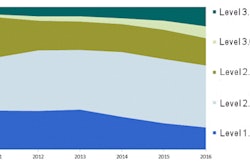
Variety may be the spice of life, but it's not really a good model for practicing medicine. A radiologist who spent two years in teleradiology said he found dramatic variations in radiology practice across the country, differences that could illustrate some of the larger issues bedeviling U.S. healthcare.
Now back in the academic world at Vanderbilt University School of Medicine, Dr. Richard Abramson said he plans to capitalize on his experience as a teleradiologist through further study of practice variation in radiology. He shared his thoughts on areas such as utilization and mix of imaging services, quality of imaging studies, use of electronic medical records, use of practice guidelines, and emergency department care in a commentary published in the May issue of Radiology (May 2012, Vol. 263:2, pp. 318-322).
 Dr. Richard Abramson from Vanderbilt University School of Medicine.
Dr. Richard Abramson from Vanderbilt University School of Medicine.In an interview with AuntMinnie.com, Abramson also discussed the need to address this variation in practice with comparative health services research, a project that he envisions could be supported by the same image management technology that enabled the teleradiology revolution.
AuntMinnie.com: What inspired you to write this article, and what were your goals for it? What kind of reaction have you received?
Abramson: My original preradiology background was in health policy and management; I had served briefly as a policy advisor in the White House Budget Office, and I had spent some time at the consulting firms McKinsey & Company and Avalere Health.
One of my main motivations in joining a teleradiology practice following residency and fellowship was getting the chance to observe the radiology landscape from "30,000 feet." I did the typical teleradiology thing, reading scans from my home office at 2:00 in the morning, but all the while I was trying to connect what I saw with larger health services and health policy themes. I thought the perspective on practice variability might be useful in kick-starting some dialogue within the radiology community on the subject.
The feedback I have received so far has been very positive in terms of validating many of the issues I raised, which is nice as an author but is ultimately discouraging for what it says about practice variability in the U.S. I have heard from radiologists around the country about variation from hospital to hospital in scanning protocols and scan quality and diagnostic algorithms, and I also heard from a radiologist in the U.K. who confirmed that the variability issue is affecting practices on both sides of the Atlantic.
As you began your stint with a teleradiology services provider, did you expect to encounter so much variability in the U.S. in the issues (utilization and mix of imaging services, quality of imaging studies, use of electronic medical records, use of practice guidelines, and emergency department care) that you highlighted in the article? What areas did you discover that concerned you the most and why?
Well, we know from the health policy and economics literature that variability in resource utilization is supposedly one of the hallmarks of the U.S. healthcare system, but seeing evidence of this variability reflected in the scans coming into my workstation was a real eye-opener. I mention in my article how different sites had vastly different protocols for working up common presentations like trauma and headache.
When I take the variability I was able to witness in emergency imaging utilization and extrapolate it to the broad range of healthcare services that are available, it's not surprising how we end up with a healthcare landscape in which per capita spending in one county can be double or triple the spending in the next county over.
I won't go as far as some economists who suggest that all of this utilization variability represents unnecessary expenditures and/or poor-quality care, but I do think it is something that merits further study, if only to understand why all the effort we put into developing appropriateness criteria and practice guidelines does not necessarily translate into real changes in ordering behavior.
Another important dimension of practice variability is that of protocol design and scan quality. Different hospital sites use vastly different imaging protocols for different indications, for example, and employ all sorts of different methods of acquiring and reconstructing CT data.
We all think our own site does things the best way, but clearly that can't be true. This is an area where I really think we can learn from each other, which is why my article proposes taking advantage of electronic networks for facilitating exchange of information between sites about what works well and what doesn't.
You refer in your article to variability in the use of electronic medical record tools. For example, while some facilities were advanced users of PACS, there were some clear laggards; the latter included facilities in which prior reports were often inaccessible, or those that had prior images archived in backup storage and unavailable for several hours after they were requested. Given the mature level of PACS software development, were you surprised to find such wide differences, and what impact did those have?
I have to qualify my answer here, as I did in my article, by saying that as a remote teleradiologist I may have underestimated the degree to which onsite radiologists had access to electronic patient health information. That having been said, though, it was pretty clear from talking with on-call technologists and reviewing final reports coming from different institutions that access to information like surgical pathology and operative reports was much easier at some hospitals than others.
I would characterize the issue this way: PACS software development is quite mature and PACS-RIS integration is also fairly mature, but PACS-RIS integration with other hospital information systems and outpatient electronic medical records has a lot of catching up to do.
I see this as a problem affecting not only quality of care, but also our ability as radiologists to position ourselves as information technology experts within larger healthcare systems. As we enter the era of accountable care organizations, radiologists are going to have to assert leadership in these nonclinical areas to avoid even further marginalization and commoditization, and we need to start by getting our own house in order.
In your commentary in Radiology, you describe the need for broadscale comparative health services research to evaluate the effects of the variability you encountered. Do you sense a lot of interest in this type of research, or do you think some might be cautious, wondering how documenting this variability might affect the perception of radiology? Is there any downside for institutions to participate?
I think the real danger lies in ignoring the variability issue or trying to sweep it under the rug. Most of us intuitively feel that practice variability is real, but moreover, most government authorities and payors also feel that it's real, and in all probability are sensing opportunities to intervene in how we practice. Now is our chance to get a handle on things ourselves and make change from within. If we don't, regulators and payors will start doing it for us, and we may not be happy with the results.
How do you think this research could affect the future of radiology?
Comparative health services research offers potential benefits to radiology on several levels. Research into why utilization patterns vary from one hospital to the next would help us, as a profession, to respond more intelligently to policy initiatives aimed at curbing inappropriate imaging use.
Research into variation in scanning protocols has obvious quality-of-care implications, and is something we should be looking to for help with maximizing diagnostic yield while minimizing radiation exposure for our patients. Research into use of technologists and use of electronic medical records would help practices benchmark their own operations against their peers.
And all of these research efforts would supplement other longstanding initiatives from the [American College of Radiology (ACR)] and other radiology professional organizations in demonstrating to outsiders looking in that we are interested and invested in our own improvement. Reasserting our commitment to these efforts is paramount for safeguarding our professional autonomy from those who would seek to take it away.



















